

The Importance of Foot Balance in the Foal to 4-Year-Old
Should I worry about foot balance in my Youngsters? - Our Futurity Head Veterinarian Dr Jane Nixon explains the importance of foot balance management in young horses. Our Nutritionist expert from Baileys, Emma Short, explains the impact of feeding on foot balance and development.
We all want our horses to be happy athletes, whatever their discipline, and to enjoy a long career ar a sound riding horse. Regardless of whether we dream to achieve a podium place, or simply to enjoy our horse at a local riding club level, our horses must be Forward, Level & Balanced.
In order to achieve this, the horse or pony must be able to move and load evenly on both sides, i.e. be as near bilaterally symmetricalas is possible.
Asymmetry of whatever nature will over time lead to imbalance. This will lead to poor performance and discomfort for the horse, which often expresses itself as lameness. This means that foot balance management is not only essential for the very top athletes in our horses, but is an important welfare concern for horses and ponies at every level.
Conformation , which is largely genetically controlled , can no longer be modified after 2-3 years of age, when the growth plates have finished closing – the precise speed at which this happens is dependent on breed. What is important to remember is that this process starts from birth, and that therefore the more we do the earlier, the better.
The good news is that a lot of the variables that are key to achieving a well balanced conformation can by affected positively through the right management. These include:
The largest influence over correct limb development undoubtedly include
In the following, we will first of all focus on foot balance and farriery, as well as on feeding for the correct body condition.
Regardless of breed, all horses’ and ponies’ feet grow from the moment they are born, which is why it is so important that close attention to detail should be paid by everyone, from the owner or carer to the farrier and vet at very regular intervals to monitor feet growth and development. In the initial stages, this should happen very regularly, ideally at least every three weeks.
Hoof Cap Growth
The hoof capsule comprises the wall, frog and sole and grows continuously. This growth is highly variable and influenced by loading and nutrition. The balance of the hoof capsule will have an effect on the rest of the horse’s or pony’s body from day 1 to maturity.
Correct shoeing in due course can play an important role in maintaining the balanced hoof capsule, and it can provide additional support specific to a particular discipline.

This picture illustrates some examples of imbalance that we must watch out for. It is important to remember that the hoof wall will revert towards imbalance within 20 minutes of trimming, unless the hoof capsule is balanced from side to side and back to front. This explains why it is so crucial that great care is taken with correct farriery.

Medio lateral [inside-outside] Imbalance ie Imbalance from Side to Side
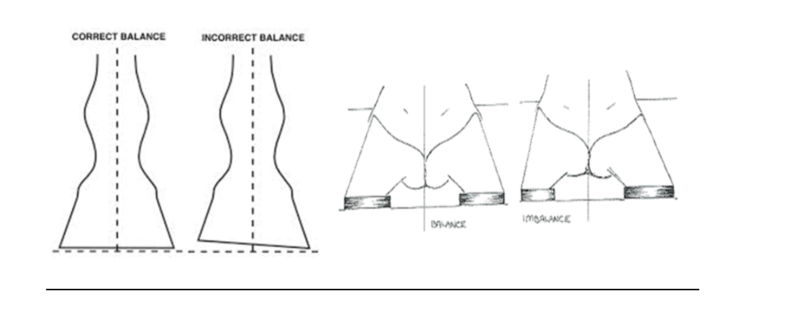
These illustrations show what happens to loading when a foot is imbalance from side to side. Again, we can see how imbalances lead to strain and increased compression that will affect performance, movement and soundness.
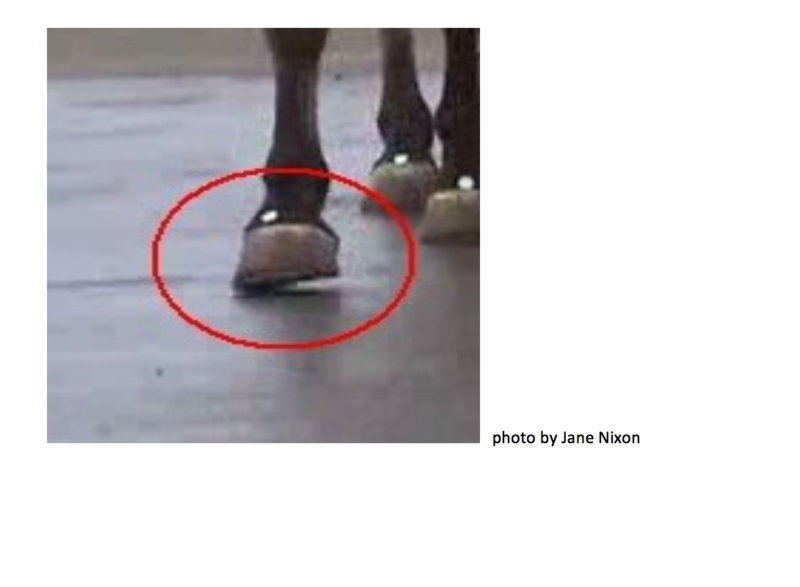
Medio Lateral Imbalance i.e. Outside High
This picture illustrates what happens when a horse’s or pony’s foot loads unevenly from side to side: the opposite side to the side that foots down first experiences whiplash at all the joins up the leg.
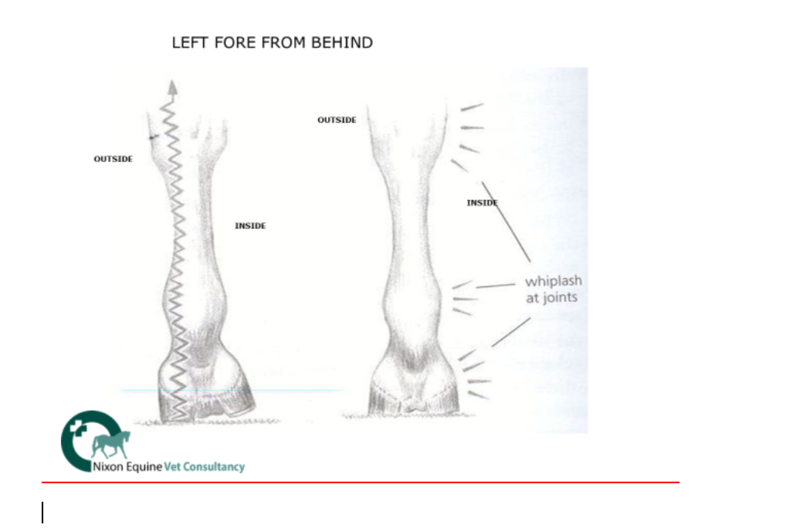
These x-ray images show what happens to the joints in an imbalanced foot vs. a balanced foot.

In the unbalanced foot on the right we can see the compression of the medial joints of the limb in comparison with the opening of the lateral joints [L]. Over time this will cause osteoarthritis of these joints. In comparison to that, we can see that in a well-balanced limb, the joint spaces are parallel from side to side.
Subclinical Fractures in Foals due to Medio Lateral Imbalance
In foals, such imbalances can cause fractures that often go undetected by owners or keepers, as they are not painful, and will therefore not show up as lameness. They can cause difficulties later on in life, including imbalance and lameness. This is why attention to detail and professional advice and monitoring from an early age are crucial!
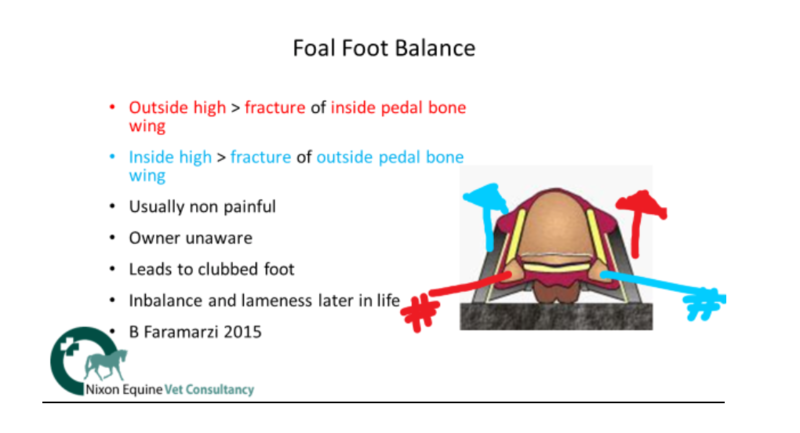

The most common causes of developmental limb deformities are
AP Imbalance and Asymmetrical Heels & the Consequences
Imbalance :- Front to Back [anterior- posterior]

The following illustrations show some of the issues that occur when horses or ponies have uneven feet. These include not only problems in the feet and limbs, due to increased strain, but also issues elsewhere in the body, as uneven loading can lead to problems in carriage and back pain.
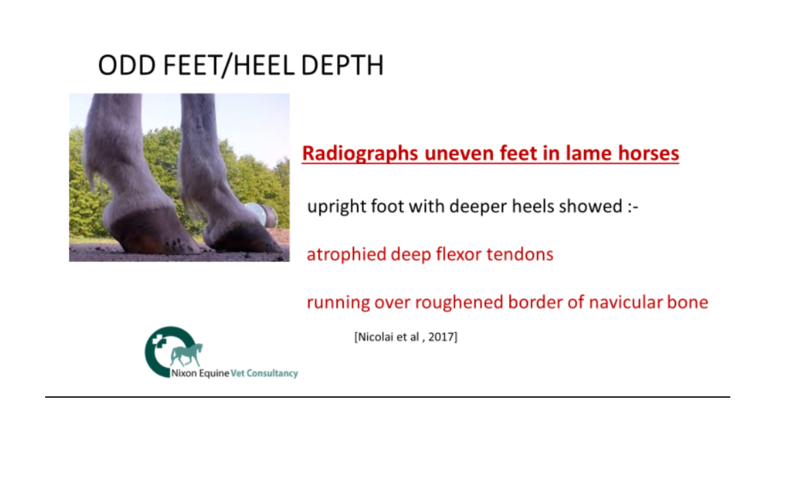
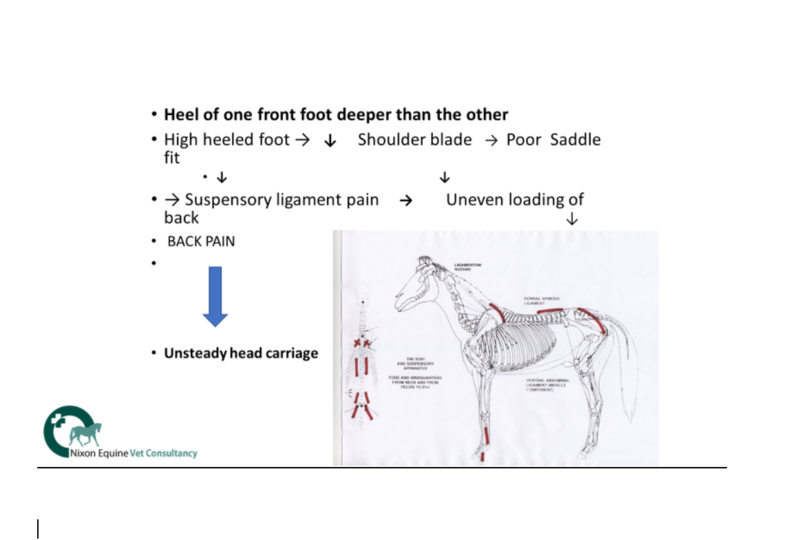
The Importance of the Hind Limb for Carriage
To explore the relationship between the feet, limbs, and carriage of the horse a little further, we need to understand a little more about the conformation traits of horses.
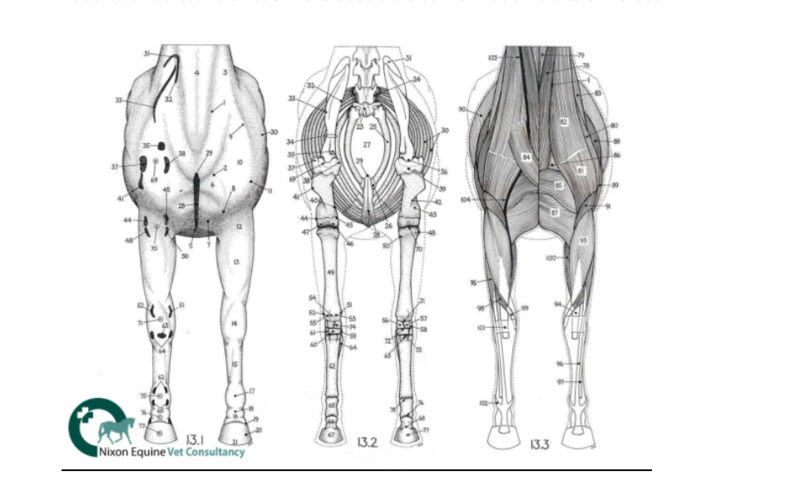
Different from us, horses and ponies do not have collar bones. This means that their torso is attached, or slung, within a muscular sling between the forelimbs with no bone – joints attachments between the sternum and shoulder joint.
|
This is different in the hind quarters, where we see the pelvis jointed to the spine via the sacroiliac joint, and the hind limbs joined to the pelvis by the hip joint. Therefore the hind limb will have a far larger influence on the functioning of the spine than the forelimbs, which have no joint attachment , just a muscular sling. This means that we need to particularly aware of the effect of imbalances in the hind feet on performance and lameness. |
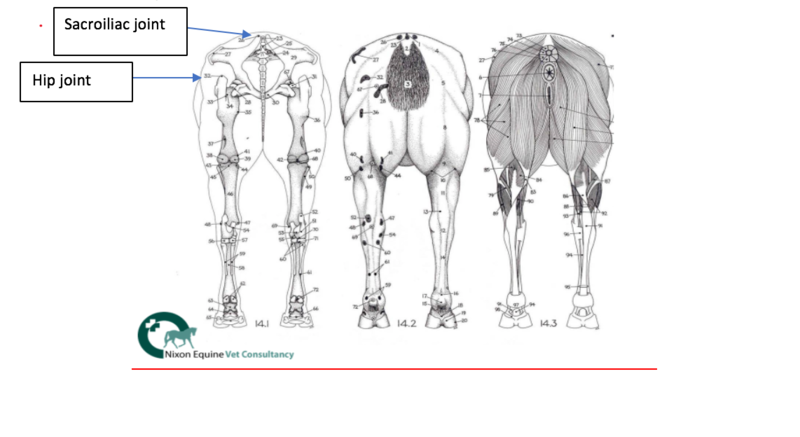
Here is a closer illustration of the sacroiliac and hip joints, which are the two connections between the hind limb and the spine.
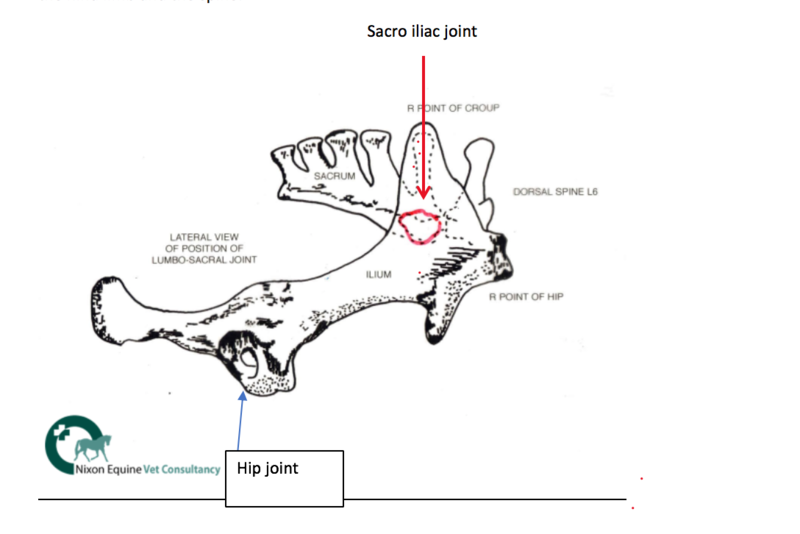
Therefore, hind feet balance is the single most important aspect when managing a horse or pony for soundness and performance. It is more important than front feet balance, because the hind limbs are attached to the axial skeleton at the Sacroiliac and Hip joints.
A long toe and low heel slows the breakover in the horse’s movement and leads to pelvic pain.
Medio Lateral imbalance will affect hind limb torque and cause pelvic asymmetry, which will lead to back pain and an unsteady head carriage.
Research has also shown that there is a direct relationship between limb length and pelvic movement asymmetry. An artificial change in limb length through application of an orthotic lift showed increased weight support associated with the shorter limb, and increased push off associated with the longer limb.[1]
Even small differences and imbalances in the hind feet can therefore have a big impact on the symmetry of the pelvis and therefore movement. Over time, due to these imbalances and direct effects on pelvic symmetry, the hind feet will become more imbalanced, which in turn causes further asymmetry and torque on the pelvis.
Effect of Exercise and Ground Surface
Our observations of some 400 foals and young horses at the Futurity in 2018 have shown a marked reduction in joint inflammation [epiphysitis] in all ages of youngstock.
A possible reason for this could be the reduced calorific intake due to long hot summer and hence less limb overloading due to excessive body condition.
It is very interesting to note that this is very apparent despite the hard ground also associated with the same weather conditions.
We look forward to studying this aspect of youngstock development in future years to further our understanding.
This leads us into our next top of discussion, which is explored by Emma Short, our Nutritionist advisor from Baileys.
Foot Balance and Nutrition
There are many possible causes of orthopaedic disorders and imbalance in the young horse and although genetics can determine factors, such as speed of growth and ability to absorb nutrients and unbalanced diet can be a major contributing factor. Whether this manifests itself in underfeeding essential nutrients or over feeding so the young horse is carrying too much weight and thus increasing load on young limbs.
As a general rule, problems evident in all four limbs are likely to be related to nutrition or genetics, whilst those appearing in a pair of limbs could be caused by management or conformation. If only one leg is affected, it is likely to be related to conformation or trauma.
Who’s at risk?
Fast growing horses – it is thought that bone is not as dense under high-speed growth conditions in comparison to bone which matures more slowly.
Youngsters on a high calorie/energy diet eg. consuming large volumes of mother’s milk, consuming particularly calorific milk, eating lots of rich pasture. High calorie/energy intake has been shown to increase growth rates and therefore the risk of problems, especially when the supply of other nutrients is insufficient to support the rate of growth.These type of diets stimulate the foal to grow quickly and yet doesn’t supply the building blocks that are required to develop the tissue correctly.
Horses on high cereal thus starch diets – these create a high glycaemic response, affecting the dynamics between glucose and insulin metabolism. Large amounts of starch in growing horses’ rations, especially if meal sizes are excessive, have been shown to correlate with a higher risk of growth problems.
Horses that have compensatory growth spurts because they have not been receiving an even plane of nutrition during growth. This can happen when they have had insufficient nutrients, especially energy, followed by excess, for example, youngsters who have been stabled, with restricted feed and exercise in the winter, then turned out on to lush spring grass.
How can I reduce the risk?
Limit high energy/calorie diets which may fuel faster than optimal growth rates and cause overweight youngsters, placing additional trauma on young limbs.
For suckling foals, consider weaning. Discuss with your vet, if necessary.
Control access to rich grazing and provide alternative, lower calorie forage sources, in order to maintain fibre intake.
Control cereal/starch intake - choose cubes over mixes or combine Stud Balancer with highly digestible fibre sources.
Keep meal sizes small.
Focus on micronutrients - these must be balanced with the energy density of the diet. It is thought that a high energy/calorie diet accompanied by an inadequate supply of minerals often results in developmental problems.
Stud Balancers provides essential nutrients, including trace minerals, without the calories associated with a traditional mix or cube.
Monitor growth rates - Use a weighbridge or weightape to plot a youngster’s rate of growth on a chart. This will enable changes to be spotted and the diet to be altered accordingly.
Periods of rapid growth are associated with skeletal abnormalities. Although it is unlikely that a completely smooth growth pattern will be achieved, avoiding significant growth rate changes is preferable. An increase in dietary energy/calories will increase the rate of growth up to the genetic potential. Dietary energy provided in excess of this requirement will either be stored as fat or could potentially contribute to fizzy or excitable behaviour. This emphasises the importance of feeding according to current weight, condition and age, which will need reassessed on an ongoing basis
The bottom line
Provide lower cereal/starch feeds to growing horses that may be at risk of growth problems. This means feeding a higher fibre diet, while fat/oils can be used as an additional calorie source, if required.
Do not allow youngsters to carry excess condition. Regular body condition scoring, using a visual and hands-on assessment method, will help monitor levels of body fat. Likewise, plotting bodyweight (using a weightape or weighbridge) on a growth monitoring chart will keep an eye on growth rates.
Keep nutrients balanced, providing quality protein for muscle and top line along with sufficient minerals - ensure you are feeding, either the recommended amount of a stud-specific cube or mix or ‘topping up’ nutrient levels with Stud Balancer, or feeding the recommended amounts of Stud Balancer alone.
Protein is not considered an energy/calorie source to the horse and is an essential nutrient in order to support correct growth and development. Energy/calories will come from either carbohydrates for example cereals or fibre and oils so be mindful that choosing a lower protein diet for your growing youngster is likely to cause a nutrient imbalance.
Consider the diet of the broodmare for future foals – feed correctly from conception.
[1]RVC June 2018 [unpublished]